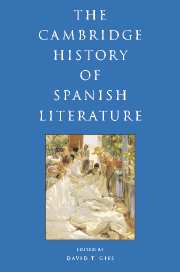Book contents
- Frontmatter
- I INTRODUCTION
- II HISTORY AND CANONICITY
- III THE MEDIEVAL PERIOD
- IV EARLY MODERN SPAIN: RENAISSANCE AND BAROQUE
- 7 Renaissance and Baroque: continuity and transformation in early modern Spain
- 8 Religious literature in early modern Spain
- 9 Renaissance poetry
- 10 The antecedents of the novel in sixteenth-century Spain
- 11 Miguel de Cervantes
- 12 The making of Baroque poetry
- 13 The development of national theatre
- 14 Lope Félix de Vega Carpio
- 15 Pedro Calderón de la Barca
- 16 Didactic prose, history, politics, life writing, convent writing, Crónicas de Indias
- V THE ENLIGHTENMENT AND NEOCLASSICISM
- VI THE FORGING OF A NATION: THE NINETEENTH CENTURY
- VII THE MODERN, MODERNISMO, AND THE TURN OF THE CENTURY
- VIII TWENTIETH-CENTURY SPAIN AND THE CIVIL WAR
- IX IN AND OUT OF FRANCO SPAIN
- X POST-FRANCO SPANISH LITERATURE AND FILM
- Bibliography
- Index
- References
8 - Religious literature in early modern Spain
from IV - EARLY MODERN SPAIN: RENAISSANCE AND BAROQUE
Published online by Cambridge University Press: 28 March 2008
- Frontmatter
- I INTRODUCTION
- II HISTORY AND CANONICITY
- III THE MEDIEVAL PERIOD
- IV EARLY MODERN SPAIN: RENAISSANCE AND BAROQUE
- 7 Renaissance and Baroque: continuity and transformation in early modern Spain
- 8 Religious literature in early modern Spain
- 9 Renaissance poetry
- 10 The antecedents of the novel in sixteenth-century Spain
- 11 Miguel de Cervantes
- 12 The making of Baroque poetry
- 13 The development of national theatre
- 14 Lope Félix de Vega Carpio
- 15 Pedro Calderón de la Barca
- 16 Didactic prose, history, politics, life writing, convent writing, Crónicas de Indias
- V THE ENLIGHTENMENT AND NEOCLASSICISM
- VI THE FORGING OF A NATION: THE NINETEENTH CENTURY
- VII THE MODERN, MODERNISMO, AND THE TURN OF THE CENTURY
- VIII TWENTIETH-CENTURY SPAIN AND THE CIVIL WAR
- IX IN AND OUT OF FRANCO SPAIN
- X POST-FRANCO SPANISH LITERATURE AND FILM
- Bibliography
- Index
- References
Summary
Much of what was written, published, and read in early modern Spain could be described as “religious literature” – over 3,000 books, by one estimate. The figures for subcategories of religious works are similarly impressive. Melquíades Andrés Martín’s recent history of mysticism in Golden Age Spain includes a bibliography of 1,200 “books of spirituality” written in Latin, Catalan, and Spanish; 444 individual hagiobiographies were published between 1480 and 1700, a figure that does not include re-editions, popular collections of saints’ lives, or the 507 works on the Virgin Mary. The total figure for “religious literature” would be even greater if we included popular religious printing (inexpensive broadsheets, pamphlet-sized catechisms, and primers, almost all of which have been lost); farsas (short mystery plays) and autos sacramentales (one-act plays celebrating the Eucharist); ecclesiastical publications (Holy Scripture and works of the church fathers, works on canon law, sermons, and guides for the clergy); devotional poetry; and imaginative literature such as Mateo Alemán’s Guzmán de Alfarache and Cervantes’ Los trabajos de Persiles y Sigisumunda (both narratives of Christian redemption), or the many chivalric and pastoral novels allegorized “a lo divino” (“in the divine style”). Suffice it to say that religious literature, even when the most narrow definition of this term is applied, enjoyed wide diffusion. Inventories of sixteenth-century printer–booksellers reveal stocks of tens of thousands of religious works available for the cost of a few maravedís – a fraction of an unskilled laborer’s daily wage. Although few of these works, even the “best-sellers” of their day, form part of our contemporary academic canon, literary historians such as Keith Whinnom and Elizabeth Rhodes have begun to recognize the need to understand their cultural significance and the reasons for their appeal for the men and women of early modern Spain.
- Type
- Chapter
- Information
- The Cambridge History of Spanish Literature , pp. 149 - 158Publisher: Cambridge University PressPrint publication year: 2005
References
- 1
- Cited by



